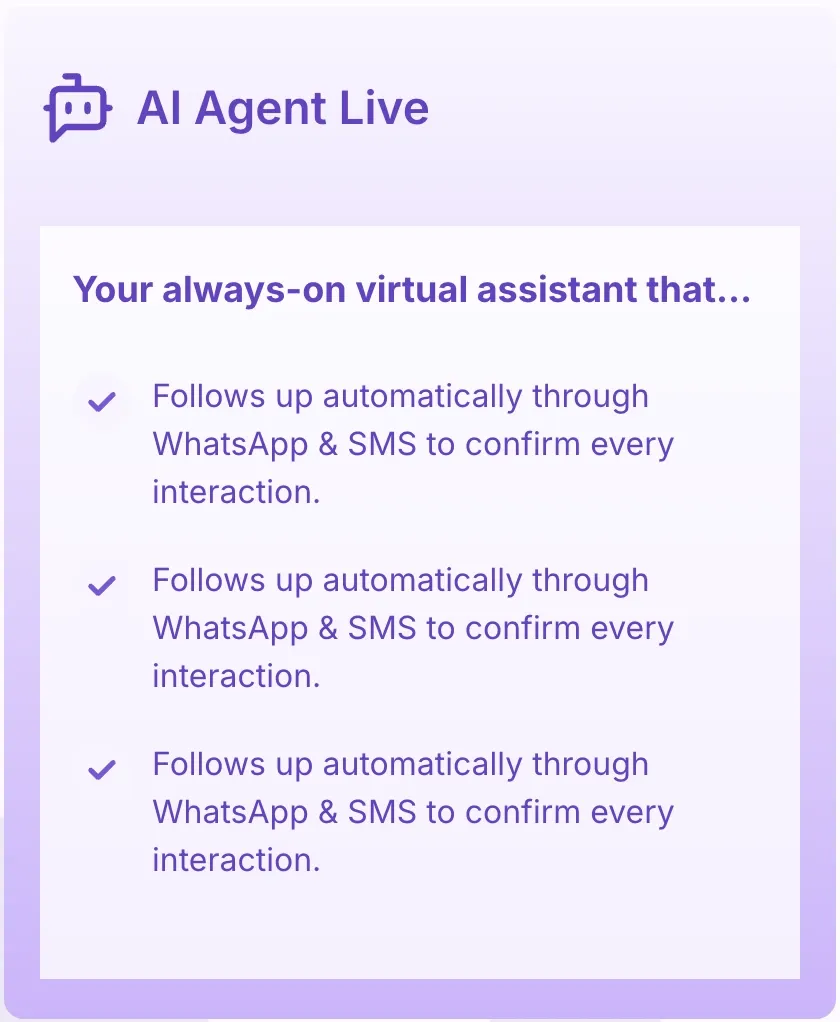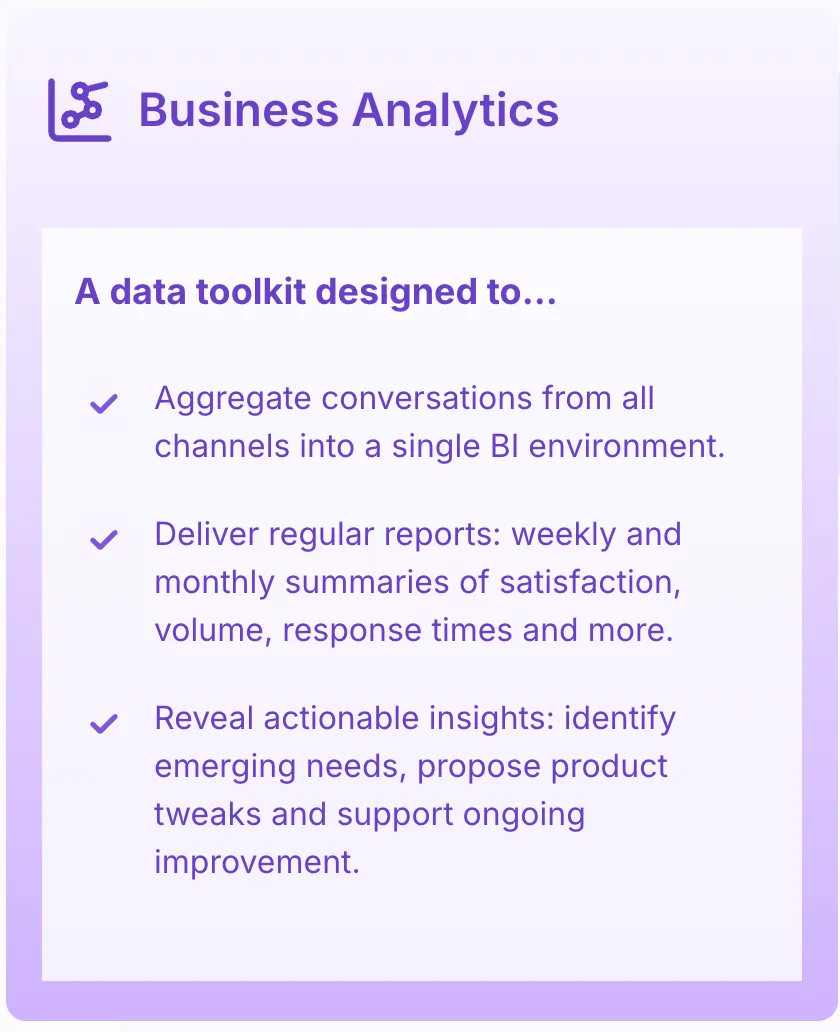NPS software has changed the way businesses gather and understand customer feedback. These tools automate the entire process, from sending out surveys to analyzing the data, making it easier than ever to understand how customers feel and make improvements based on their feedback.
In 2024, improving your NPS can have a significant impact on your business growth:
- Enhanced Customer Retention: A higher NPS means more loyal customers
- Reduced Operational Costs: Automated feedback collection saves time and resources
- Data-Driven Decision Making: Real-time analytics help identify areas for improvement
- Competitive Advantage: Understanding how customers feel gives you an edge in the market
Modern NPS platforms offer advanced features like:
- AI-powered text analysis
- Multi-channel survey distribution
- Real-time alerts
- Custom reporting dashboards
- CRM integration capabilities
By using the right NPS strategy with powerful software tools, you can turn customer feedback into actionable insights that lead to sustainable growth and improved efficiency in your business.
Understanding Net Promoter Score and Its Impact
Net Promoter Score (NPS) is a powerful metric that measures customer loyalty through a single, straightforward question:
"On a scale of 0 to 10, how likely are you to recommend our product/service to a friend or colleague?"
This standardized approach divides your customers into three distinct categories based on their responses:
- Promoters (Score 9-10): Your brand advocates who fuel business growth through positive word-of-mouth
- Passives (Score 7-8): Satisfied but unenthusiastic customers vulnerable to competitive offerings
- Detractors (Score 0-6): Dissatisfied customers who can damage your brand reputation
How NPS is Calculated
The NPS calculation follows a simple formula:
NPS = % of Promoters - % of Detractors
Let's break down a practical example:
- Total respondents: 100
- 60 Promoters (60%)
- 20 Passives (20%)
- 20 Detractors (20%)
- NPS = 60% - 20% = 40
Your NPS can range from -100 (all detractors) to +100 (all promoters). This scoring system provides clear insights into your customer base's loyalty levels.
The Strategic Value of Customer Segmentation
Understanding your customer segments enables targeted strategies:
- Promoters: Leverage their enthusiasm through referral programs and testimonials
- Passives: Create personalized engagement campaigns to boost their loyalty
- Detractors: Address concerns quickly to prevent negative word-of-mouth
This segmentation allows you to:
- Allocate resources effectively
- Design targeted marketing campaigns
- Implement specific retention strategies
- Track changes in customer sentiment
- Identify patterns in customer behavior
By monitoring these segments, you can predict potential issues, capitalize on opportunities, and make data-driven decisions to enhance customer relationships.

Step 1: Choose the Right NPS Software for Your Business Needs
Selecting the right NPS software sets the foundation for successful customer feedback management. Your ideal platform should align with your business scale, budget, and specific requirements.
Essential Features to Look For:
- Automated survey distribution across multiple channels
- Real-time feedback alerts and notifications
- Comprehensive analytics and reporting capabilities
- Custom branding and survey personalization options
- Mobile-responsive design
- Data security and compliance measures
Top NPS Platforms Comparison 2024:
Platform Starting Price Key Features SurveyMonkey | $25/user/month | Expert-designed templates, multiple distribution channels, third-party integrations |
Zonka Feedback | $49/month | Omnichannel feedback collection, real-time monitoring, instant alerts system |
Delighted | $17/month | 30+ language support, multi-channel survey distribution, open-ended follow-up questions |
CRM Integration Benefits
Your NPS software needs seamless CRM integration to:
- Track customer interactions across touchpoints
- Create targeted marketing campaigns
- Personalize customer communications
- Automate follow-up actions
- Maintain updated customer profiles
Dashboard Features That Matter
User-friendly dashboards enhance your NPS program by providing:
- Real-time score tracking
- Customer segment visualization
- Response rate monitoring
- Trend analysis tools
- Custom report generation
The right NPS software combines these elements while staying within your budget. Consider starting with free trials offered by platforms like Zoho Survey or ProProfs Survey Maker to test their functionality. Your chosen solution should scale with your business growth and integrate smoothly with your existing tech stack.
Step 2: Automate and Customize Your NPS Surveys Effectively
Automation transforms your NPS survey process into a streamlined operation across multiple channels. You can distribute surveys through:
- Email campaigns with triggered follow-ups
- SMS messages for immediate feedback
- Web links embedded in your website
- Mobile app notifications
- Social media platforms
- In-app prompts
Smart Survey Customization
Your NPS surveys need to reflect your brand identity. Leading platforms like ProProfs Survey Maker offer extensive customization options:
- Brand colors and logo placement
- Custom question formats
- Multi-language support
- Mobile-responsive designs
- Personalized thank-you messages
- Follow-up question branching
Behavior-Based Survey Scheduling
Trigger surveys based on specific customer actions:
- Post-purchase interactions
- Service completion
- Account milestones
- Product usage patterns
- Website visit frequency
- Customer lifecycle stages
AI-Powered Response Analysis
Modern NPS tools leverage artificial intelligence to extract meaningful insights:
- Sentiment analysis of open-ended responses
- Pattern recognition in customer feedback
- Automated categorization of issues
- Trend identification
- Priority flagging for urgent concerns
- Predictive analytics for customer behavior
Survey Distribution Best Practices
- Set optimal timing intervals between surveys
- Segment audiences for targeted distribution
- A/B test different survey formats
- Monitor response rates by channel
- Adjust survey length based on completion rates
- Implement smart reminder systems
The right combination of automation and customization creates engaging surveys that boost response rates. Your NPS software should adapt to your customers' preferences while maintaining consistent branding and messaging across all touchpoints.

Step 3: Analyze Customer Feedback Using Advanced Analytics and Reporting Tools
Modern NPS software equips businesses with powerful analytics capabilities to transform raw feedback data into actionable insights. Real-time dashboards serve as your command center, displaying instant updates on customer sentiment shifts and enabling swift responses to emerging issues.
Key Dashboard Features:
- Sentiment tracking across promoter segments
- Response rate monitoring
- Alert systems for negative feedback
- Visual data representation
- Custom report generation
Advanced trend analysis helps you spot patterns in customer loyalty over time. You'll identify seasonal fluctuations, measure the impact of service improvements, and predict future satisfaction trends. Tools like SurveySensum and Yellow.ai use AI-powered analytics to detect subtle changes in customer behavior that might affect your NPS.
Segmentation Analytics Benefits:
- Demographic-based insights
- Behavioral pattern recognition
- Purchase history correlation
- Channel preference analysis
- Regional performance comparison
The reporting capabilities of NPS platforms enable strategic resource allocation. When CustomerSure or Zonka Feedback highlight specific pain points, you can direct your team's efforts toward the most impactful improvements. These tools automatically categorize feedback themes, helping you prioritize action items based on frequency and severity.
Data-Driven Decision Making:
- Resource optimization based on feedback clusters
- Team performance tracking
- Service improvement prioritization
- ROI measurement for customer experience initiatives
- Automated issue escalation workflows
Advanced reporting features integrate with your existing systems to create a comprehensive view of customer satisfaction. Platforms like Qualtrics Survey and Retently provide customizable reports that align with your specific business metrics, making it easier to demonstrate the value of your customer experience investments.
Your NPS analytics toolkit should include features for both granular analysis and high-level strategic planning. This dual approach ensures you can address immediate concerns while building long-term customer loyalty strategies.
Step 4: Engage with Customers Based on Their NPS Segmentations
NPS segmentation creates distinct opportunities for targeted engagement strategies. Let's explore specific approaches for each customer group:
Nurturing Your Promoters
- Create exclusive VIP customer programs with early access to new products
- Implement referral rewards systems that offer points or discounts
- Feature customer success stories on your social media platforms
- Invite them to beta testing programs for upcoming features
- Send personalized thank-you notes acknowledging their loyalty
Converting Detractors
- Set up automated triggers for immediate response to negative feedback
- Assign dedicated customer success managers to address concerns
- Create specialized recovery programs with targeted solutions
- Implement a priority support queue for detractor issues
- Follow up within 24-48 hours to ensure resolution satisfaction
Activating Your Passives
- Launch targeted email campaigns highlighting new features
- Offer specialized training sessions on product utilization
- Create personalized product usage reports with optimization tips
- Send surveys to understand specific areas of improvement
- Develop educational content addressing common pain points
Leveraging Software for Personalized Communication
Your NPS software should enable:
- Automated response workflows based on score segments
- Custom message templates for each customer category
- Multi-channel communication preferences tracking
- A/B testing capabilities for different engagement approaches
- Integration with CRM systems for comprehensive customer profiles
Modern NPS platforms like Qualtrics Survey and Retently offer AI-powered engagement tools that automatically segment and trigger appropriate responses. These systems analyze customer feedback patterns and suggest personalized engagement strategies, making it easier to scale your customer communication efforts while maintaining a personal touch.
Remember to track engagement metrics for each segment to measure the effectiveness of your strategies and adjust your approach accordingly. Tools like Yellow.ai's platform can help predict customer behavior patterns and optimize your engagement timing for maximum impact.

Step 5: Monitor Progress Continuously and Optimize Your Customer Experience Strategy
Track NPS Progress with User-Friendly Dashboards
User-friendly dashboards serve as your command center for NPS progress tracking. These intuitive interfaces display real-time metrics, allowing you to spot trends and make data-driven decisions quickly. Your dashboard should highlight:
- Daily NPS score fluctuations
- Response rate patterns
- Customer segment shifts
- Urgent feedback alerts
Foster Cross-Departmental Collaboration for NPS Impact
Cross-departmental collaboration amplifies the impact of your NPS program. Share NPS insights through:
- Weekly team briefings with key metrics
- Department-specific reports tailored to each team's goals
- Collaborative action plans based on customer feedback
- Shared access to NPS software dashboards
Leverage AI-Powered Platforms for Predictive Insights
AI-powered platforms like Yellow.ai transform raw NPS data into predictive insights. These advanced tools:
- Analyze historical satisfaction trends
- Identify early indicators of brand strength
- Project future customer behavior patterns
- Calculate potential revenue impact
Reap Cost Benefits with Automation Capabilities
The automation capabilities of NPS software deliver substantial cost benefits:
- 60% reduction in operational costs
- Automated issue detection and prevention
- Streamlined feedback collection processes
- Efficient resource allocation based on data insights
Integrate NPS Software into Daily Operations for Strategic Advantage
Your NPS software becomes a strategic asset when integrated into daily operations. Teams can access real-time data, collaborate on improvement initiatives, and track progress toward customer experience goals. This systematic approach ensures continuous optimization of your customer satisfaction strategy.
Conclusion
Investing in the right NPS software creates a powerful foundation for sustainable business growth. The market offers diverse solutions - from comprehensive platforms like Qualtrics Survey to specialized tools like Retently - each designed to match specific enterprise needs and budgets.
Your choice of NPS software should align with three critical factors:
- Scalability: The ability to grow with your business, handling increased survey volumes and data complexity
- Integration capabilities: Seamless connection with existing CRM systems and business tools
- Cost-effectiveness: Features that deliver measurable ROI through improved customer retention and satisfaction
The implementation of NPS software transforms raw feedback into actionable insights, driving strategic decisions that enhance customer experiences. Companies using these tools report:
- 60% reduction in operational costs
- Improved customer retention rates
- Enhanced brand advocacy
- Data-driven decision making
Your NPS strategy success depends on selecting tools that match your organization's size, industry, and growth objectives. Whether you choose an all-in-one solution like Yellow.ai or a specialized platform like SurveyMonkey, the right NPS software empowers you to build stronger customer relationships and drive sustainable business growth.
Remember: The best NPS tool isn't necessarily the most expensive - it's the one that effectively captures, analyzes, and helps you act on customer feedback while delivering measurable returns on your investment.
FAQs (Frequently Asked Questions)
What is Net Promoter Score (NPS) and why is it important for measuring customer loyalty ?
Net Promoter Score (NPS) is a standardized metric that measures customer loyalty and satisfaction by asking customers to rate their likelihood of recommending a brand on a scale from 0 to 10. It segments customers into Promoters, Passives, and Detractors, providing actionable insights that help businesses enhance customer experience and drive growth.
How does NPS software automate feedback collection and improve customer experience ?
NPS software automates the distribution of surveys across multiple channels such as email, SMS, web links, mobile apps, and social media. It offers customizable survey templates, real-time alerts, AI-enabled text analysis, and integration with CRM systems to streamline feedback management and enable personalized marketing strategies that enhance overall customer experience.
What features should I look for when choosing the right NPS software for my business in 2024 ?
Key features include automated feedback collection, real-time reporting dashboards, advanced analytics capabilities, multi-channel survey distribution, seamless CRM integration for personalized communication, cost efficiency, user-friendly interfaces, and scalability. Top platforms like Qualtrics Survey, Retently, SurveyMonkey, Zoho Survey, Zonka Feedback, and Delighted offer these benefits tailored to diverse enterprise needs.
How can I effectively analyze customer feedback using NPS analytics and reporting tools ?
Effective analysis involves utilizing real-time dashboards to monitor sentiment shifts among Promoters, Passives, and Detractors; performing trend analysis to understand long-term loyalty changes; leveraging segmentation analytics to identify key demographics; and using advanced reporting to allocate resources efficiently for service improvements and closing the feedback loop promptly.
What strategies can I use to engage with customers based on their NPS segmentation ?
Engage Promoters by nurturing them into brand advocates through exclusive offers or loyalty programs. Convert Detractors by promptly addressing pain points using real-time alerts from your NPS software. Boost Passives' satisfaction with targeted campaigns aimed at elevating them to Promoters. Feedback management software facilitates personalized communication at scale to enhance customer loyalty effectively.
Why is continuous monitoring of NPS important for optimizing customer experience strategy ?
Continuous monitoring using user-friendly dashboards provides actionable insights that enable timely interventions. Sharing NPS data company-wide encourages cross-departmental collaboration aligning improvement efforts. Trend analysis predicts business growth by tracking satisfaction patterns over time while automation reduces operational costs through efficient issue prevention—maximizing ROI from your customer experience strategy.












